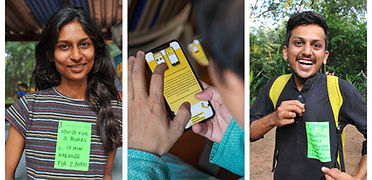karishma mehrotra
writer
Scroll.in
For six months, I wrote technology magazine stories for the online outlet. I also was awarded an Earth Journalism Network grant to write a separate series on energy and labour for Scroll.in.
All of my work with Scroll.in is here.
TOP READS:
The changing face of coal labour
Pressure for production has intensified, but demand for labour has plummeted. I visited six mines across three districts in Jharkhand to understand how coal labour has changed in the face of immense privatization. Uprisings at mines lead to mass arrests and terminations as employment has become more precarious. I completed two videos along with a long feature from the field. This was the first part of a two-part series on energy and labour, funded by Earth Journalism Network.
As India contemplates how to construct a green future, the employment scenario may prove to be the largest obstacle. I visited one of India's largest solar parks to find that the job numbers on paper didn't match the ground reality, where only a few scattered construction helmets could be seen at any time. I produced a video along with a long feature. This was the second in a two-part series on energy and labour, funded by the Earth Journalism Network.
Trying to save a language by bringing it online
The average-looking tree that sits in front of his village’s school is the only place in Odissa’s Dighiabeda where he can catch the network. Between this trunk and the studio where he works taking passport photos in the nearby town Baripeda, he spends hours online with one mission in mind: spread the Ho language. His meandering journey shows the struggle indigenous Indian languages face in making digital inroads.
‘We’re being pushed into poverty’: Voices of women gig workers who took on the unicorn start-up
In October, she says, she considered killing herself. “I had hit a low,” she said. “The pressure made me sick.” Other beauticians with Urban Company rushed to help – a moment which Chander believes crystallised their anger into what was possibly India’s first women-led gig workers’ strike.
Jharkhand's energy push lies on the roofs
Every other day, Reyajudin Ansari clambers up the narrow, dark staircase of his one-bedroom brick home to the terrace, where he wipes off the layers of soot deposited on his solar panels by nearby coal mines.
There is a touch of pride in the 45-year-old tailor’s voice as he talks about the silvery panels that began a domino of events in the village.
India digs into the (lab) meat
The biggest obstacle of all: getting the right flavour and texture. For the cultured mutton to sell, it has to taste like, well, mutton. But what makes mutton mutton or chicken chicken?
Rao likens growing cultured meat to creating a perfume. “It’s a combination of molecules,” he explained. His process for developing sheep meat involves boiling regular meat, collecting the air above it, identifying the molecules, and synthetically producing them.
“You know, when you are in an Indian [apartment] complex and you can smell what your neighbour is cooking?” said Rao. “Those are the cells we need to examine.”
Auroville's virutal currency imagines a world with no money
“A high tech toilet was where we lost a lot of people”, she said. Her team of four re-molded the idea of Fecal Standard Money into the digital aura.
The community emphasies collective ownership of resources and sustainable living. The aura is emblematic of the rocky economics of Auroville itself, a work-in-progress marked by numerous attempts at renewal.
Beyond White and Black in Facial Recognition
The assessment marks the first time that researchers have evaluated facial recognition accuracy on Indian faces, in what a burgeoning group of researchers hope to be a longer journey in contextualising algorithmic fairness in an Indian context.
Most research into bias and fairness in facial recognition technology rarely moves beyond standard White and Black distinctions, while a few include an “Asian” category that broad-brushes the vast variations in the continent, Jain says. “Most Global North researchers have a view of diversity and fairness that is very restricted,” he added. “Indians don’t even end up as a category. If the researchers do include Indian faces, they don’t go beyond data sets of a few urban elite audiences from New Delhi or any other urban city.”
“If we don’t build these databases, somebody else will and they will be in control of us,” said Ramanjaneyulu. “We need to come up with indigenous solutions. Saying that there should not be a Microsoft or Google won’t work. Even if they are there, how do we protect ourselves?”
The question has become central in the world of agricultural technology, or agritech in short, as the Union Agriculture Ministry finalises India’s first major governmental push in digital agriculture – AgriStack.
Pandemic leads to online grooming rise
Over the next few weeks, he told her that he is a former army officer, over 30 years old, and in the same city as her. He began to tutor her online and her grades improved. He said he loved her.
This was the first time that I felt someone loves me, cares for me,” the girl later told Bhatia.
The man began asking for her photographs. At first, it was just her face or lips. But 10 weeks in, they began masturbating together online and sending each other nude pictures.







